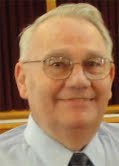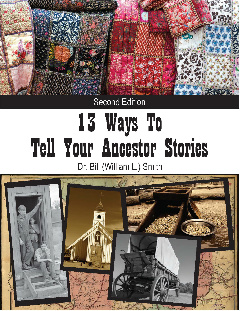Dr. Bill Smith: 13 Ways to Tell Ancestor Stories – Interview and Giveaway
Biff Barnes
Today we are happy to welcome Dr. Bill Smith who is stopping by on his blog tour for the new edition of his book The 13 Ways to Tell Ancestor Stories.
 Dr. Bill has written nine nonfiction books about family history, serves as a Squidoo lens master, contributes to The In-Depth Genealogist as The Heritage Tourist and writes a newspaper column on family history. We’re happy to have had an opportunity to chat with Dr. Bill about his latest project.
Dr. Bill has written nine nonfiction books about family history, serves as a Squidoo lens master, contributes to The In-Depth Genealogist as The Heritage Tourist and writes a newspaper column on family history. We’re happy to have had an opportunity to chat with Dr. Bill about his latest project.
Here’s our interview with Dr. Bill:
You discuss 13 ways of telling ancestor stories. You can’t really get started with them all at once. Is there a sequence you would recommend to someone just getting started telling ancestor stories?
Simple answer: Whatever will get you started. Normally, I believe, a situation will come along first to get you over the hump, to break the ice. A family gatherings or a family reunion where you will be seeing people you don’t ordinarily talk with is a great place to start. Use a simple chart, a montage of photographs, or a brochure as a means to start the storytelling. Otherwise, I highly recommend a blog as a starting point. It is relatively easy to do and allows a wide variety of options in which direction you take your storytelling.

The planning worksheets following each of the 13 ways advises your readers to think about their purposes, goals and audience. How might understanding your audience shape the way you would tell a particular story?
The better you know your audience the better you can draw on your research to pull out a story that will match their existing interests, and more likely grab and maintain their continued interest in that branch of the family history. In the book, I use an example from a fellow researcher cousin: he told a military related story from the family because he knew the folks he was speaking with were already interested in military history, and it worked very well to pique their continued interest.
You mention the problem of factual accuracy in storytelling from two perspectives: first from “family tradition stories” and then from the perspective of the skeletons in the closet where relatives say “…we don’t talk about him.” What’s your advice to storytellers to deal with the colorful family lore and legends that may not be completely accurate, or with the details about black sheep which traditionally have not been discussed?
I think it is critical to first “get the facts” and get them as accurate and complete as your research can possibly achieve. From that solid footing, you can then approach your ancestor storytelling with all of your options available. Be very sensitive about the feelings of living relatives in particular. Recognize that each and every detail of each and every story does not, actually will not, be told now, and every time. Make judicial choices. In many respects, this ties in closely with the previous question and answer, I believe. Know your audience. Give them good stories that pique their interests. You want to draw them in, not drive them away.
I was glad to see that you encouraged readers to tell their own personal stories. Why is it important for us to tell our own stories as part of the family history?
We are each a part of our family history. I am always surprised when I tell a story from my earlier days, and even one of my three daughters will say, “I hadn’t heard that before.” And we all talk a lot! Also, as you tell stories and share, it is important that these are recorded in such a way that they are available to other interested family members. That is why I like a blog. It is there for folks to read, when they are interested… even years later. A book, of course, still remains the best way to share major family stories the best for the long term. And, my bias is to always publish books in both print and electronic versions.
In the past few years, we have heard people talking about the genealogy/family history “community”. You ask readers to share their experiences with you, telling about using any of the 13 ways you suggest. It sounds as if you are beginning an ongoing conversation with them. Is it one of your goals for your book to create a community for family storytellers?
If that worked out to be case, I would be thrilled, for sure! GeneaBloggers is certainly one “community of family storytellers” of which I am proud to be a part. If my 13 Ways book contributes in any way to further developing a larger “community of family storytellers” I would be very pleased to have made that contribution. I am happy to encourage that development.
Which of the 13 ways is your personal favorite? Why?
The Blog and the Book are the ones I spend the most time on, so I suppose that answers the question. That would likely have something to do with my stage of life, of course. I’ve done some with each of the 13 ways, over the years. Doing oral interviews and creating podcasts is absolutely thrilling and very personally satisfying, for example, but I only do it rarely in recent times. I don’t go to meetings of any kind, any more, so that takes other ways out of the equation.
Where is the book available?
The 13 Ways to Tell Ancestor Stories, 2nd Edition, is now available on Amazon.com and will be available in many other outlets as time goes by. It is always available in print directly from my shop at my printer, Lulu.com: http://www.lulu.com/spotlight/drbillshares - $9.99.
Thanks, Dr. Bill, for visiting the Stories To Tell Blog. Good luck with the rest of your tour!
GIVEAWAY – We are giving away a PDF copy of The 13 Ways to Tell Ancestor Stories. To be eligible for the drawing, leave a comment below. Make sure to include a correct email address.